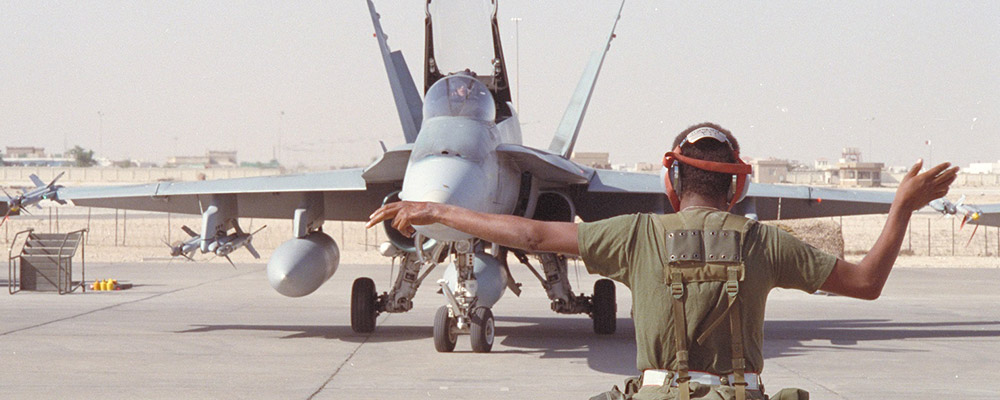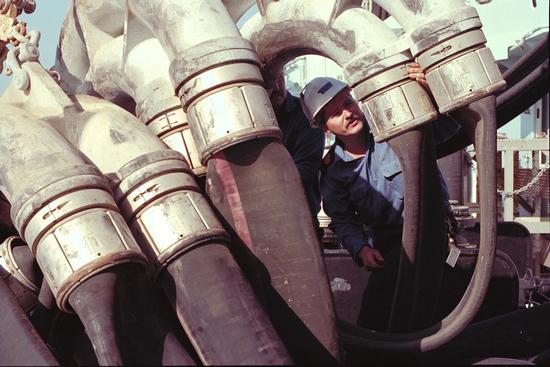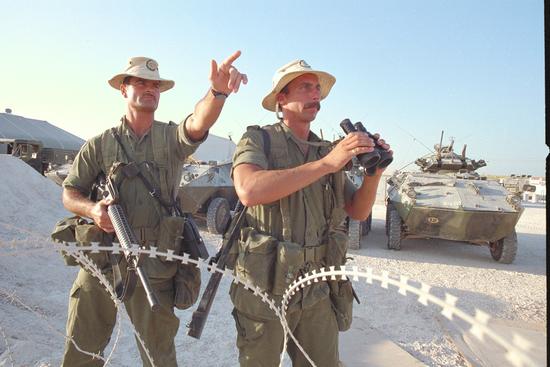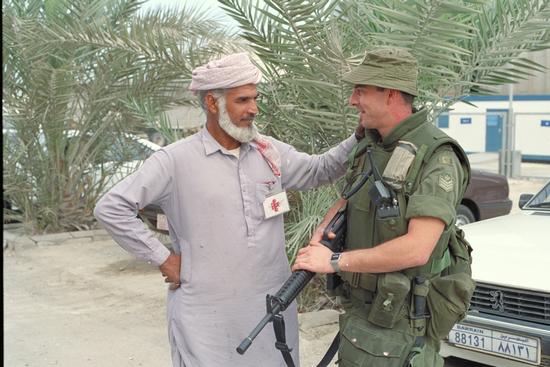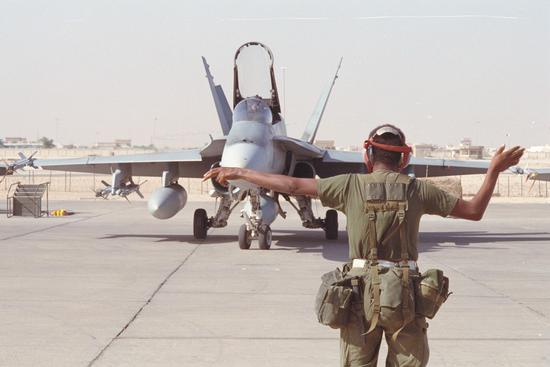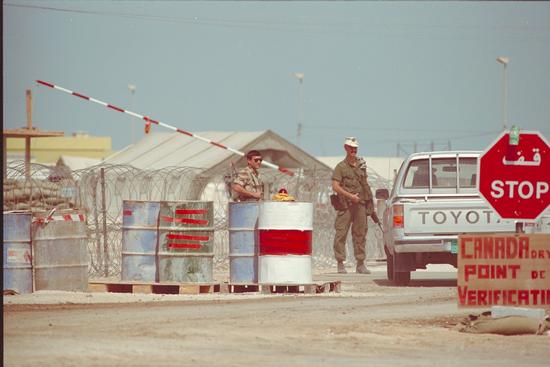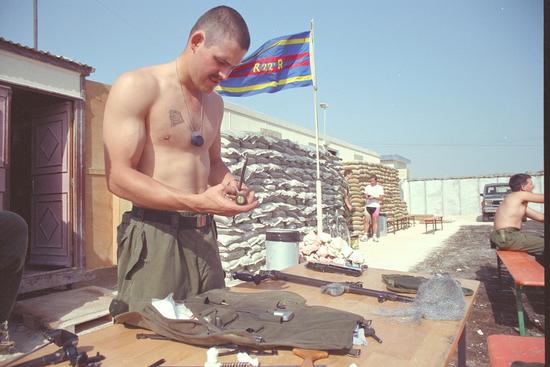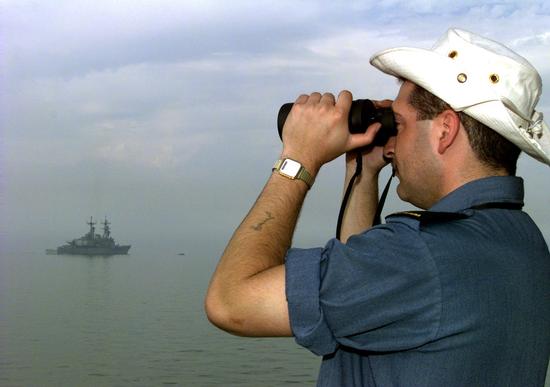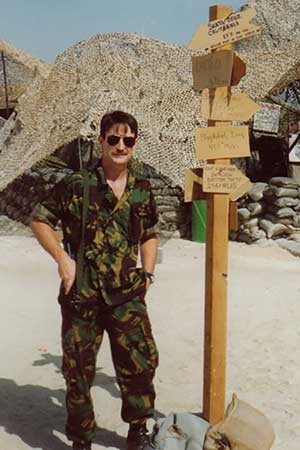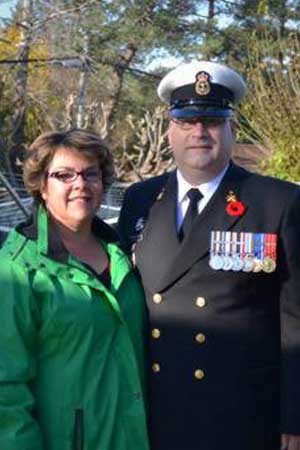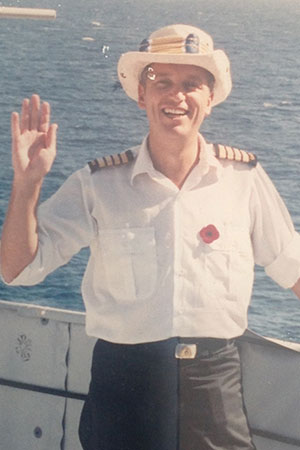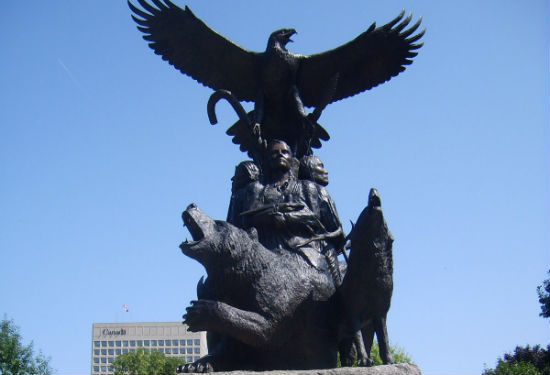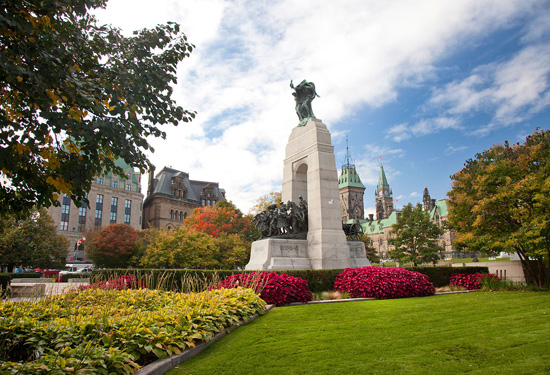Order of events
2 August 1990
More than 100,000 Iraqi troops invade Kuwait
7-8 August 1990
The United States begins Operation Desert Shield
10 August 1990
Canadian government announces military support in Persian Gulf
12 August 1990
Coalition naval blockade of Iraq begins
24 August 1990
Canadian warships set sail from Halifax for Persian Gulf
8 October 1990
First Canadian CF-18 jets arrive in the Middle East
15 January 1991
Iraq ignores United Nations deadline to withdraw from Kuwait
16-17 January 1991
Operation Desert Storm begins as Coalition forces launch first air attacks
24 February 1991
Major Coalition ground offensive begins
28 February 1991
Coalition announces a ceasefire and stops combat operations
3 March 1991
Iraq accepts ceasefire terms
Classroom materials
The Gulf War of the early 1990s was an important chapter in Canada’s military history. More than 4,000 Canadians served in the Persian Gulf region in 1990-1991 as part of a Coalition of countries. Their goal was to remove the invading forces of Iraq from neighboring Kuwait. Canadians also served in peacekeeping and embargo enforcement efforts in the region after the war. This was the first conflict where Canadian women played an active combat role.
28 February 2021 marked the 30th anniversary of the end of the Gulf War.

Tension in the Persian Gulf
(2 August 1990 – 14 January 1991)
Following Iraq's invasion of Kuwait, Canadian Armed Forces members deployed to the region. They joined the largest international coalition of military forces since the Second World War.
Uneasy neighbours
Located next to each other, Iraq and Kuwait are in the heart of the oil rich Middle East. The two nations have had a tense relationship with one another. Iraq felt that Kuwait should be part of Iraq. They also argued that Kuwait was drilling into Iraqi oil fields without permission.
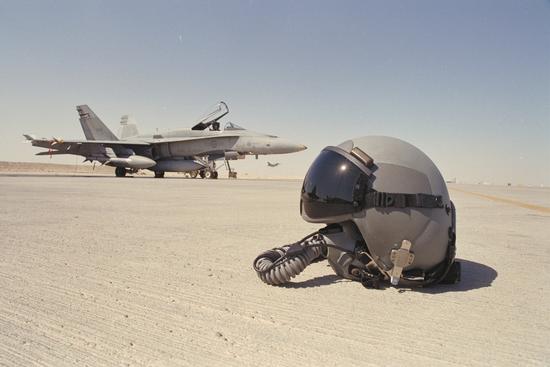
A pilot’s helmet in front of a CF-18 warplane on the tarmac of the Qatar airfield. November 13, 1990. Photo: Department of National Defence IWC90-421-24
Iraq threatens aggression
The Iran Iraq War in the 1980s created new tensions in the region. Arguments over oil production and debts worsened Iraq's relationship with its neighbours. The West was very concerned with Iraq's ability to restrict access to a large part of the world's oil supply. The United States and other countries began to call out Iraq for their human rights abuses.
Saddam Hussein, the leader of Iraq, felt the international community was being unfair. Diplomatic relations deteriorated. Iraq threatened its neighbours with claims of biological and chemical weapons. Hussein soon moved tens of thousands of troops to the Iraqi Kuwait border. In response, military forces in the region went on high alert.
On the attack
On 2 August 1990, roughly 100,000 Iraqi soldiers invaded Kuwait. Within hours, the United Nations passed a resolution condemning the attacks. A Coalition of over 35 countries, led by the United States, soon came together to stand up for freedom. It was the largest union of forces since the Second World War. They gave Iraq a deadline to withdraw their troops. The United Nations also gave authorization to use any means necessary to enforce this. Not all Coalition countries provided military support. Some imposed economic sanctions or suspended aid to Iraq to put pressure on the Middle Eastern nation. A naval blockade by a Coalition fleet helped cut off shipping to the Iraqi regime. Operation Desert Shield was the codename for the Coalition's military build up.
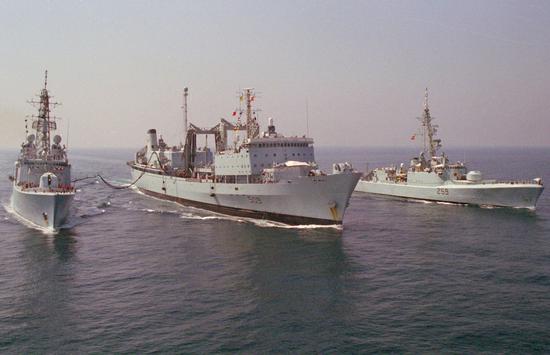
Canadian warships conduct replenishment at sea en route to the Persian Gulf: (from left) HMCS Athabaskan, Protecteur and Terra Nova. September 1990. Photo: Department of National Defence
Attempts to negotiate
In late August 1990, Saddam Hussein appeared on television with Western hostages. He used several tactics to try to gain the upper hand in negotiations with the Coalition. United Nations and Coalition countries still demanded that the Iraqis withdraw from Kuwait. If they did not, Coalition forces would launch a major military campaign to drive them out.
The Canadian response
On 10 August 1990, the Canadian government announced it would offer military support to the Coalition forces. The Canadian Armed Forces (CAF) involvement in the Gulf War was code named Operation Friction. Our main military contributions were our warships and aircraft. On 24 August 1990, the destroyers HMCS Terra Nova, HMCS Athabaskan and the supply ship HMCS Protecteur sailed from Halifax for operations in the Persian Gulf. On 8 October 1990, Canada's first CF 18 jet fighters arrived in the Middle East. It was the first time in decades that Canadian air and naval forces worked together in a war zone. It was also the first time Canadian women served in combat roles during a conflict. More than 4,000 CAF members served in the Gulf War. At its peak, there were 2,700 Canadian personnel in the region at one time.
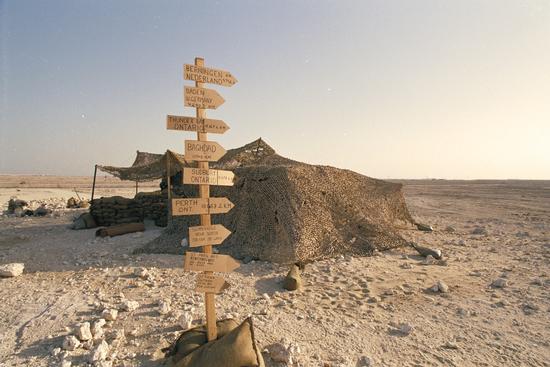
A defensive position on ‘Bunker Hill’ at the end of the runway of the Canadian base in Qatar. December 2, 1990. Photo: Department of National Defence IWC90-409-28
Joint headquarters
The Gulf War was the first time the CAF naval and air commands supported each other during a conflict. The commands were first unified in 1968. The CAF created a joint headquarters in Manama, Bahrain in November 1990, which organized Canada's military efforts during the Gulf War.
Naval and air operations during Desert Shield
The Coalition fleet patrolled the Persian Gulf during Operation Desert Shield. Our warships stopped vessels trying to evade the blockade. Five Sea King helicopters worked with the warships, performing a variety of tasks.
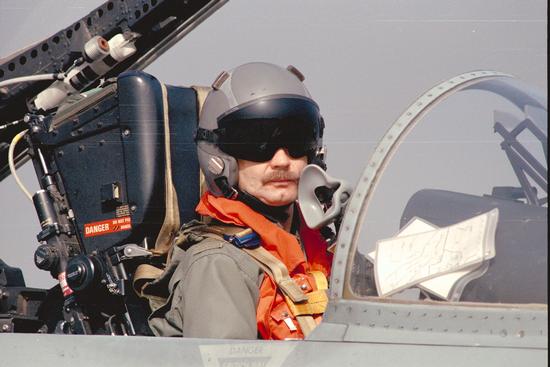
Lieutenant-Colonel Don Matthews, commanding officer of the No. 439 Squadron (Desert Cats), prepares for a mission. February 22, 1991. Photo: Department of National Defence ISC91-5385
Canadian warplanes patrolled the Coalition's defensive lines, turning back Iraqi planes that came too close. Sometimes our CF-18s provided air cover for Coalition ships. Canadian transport planes carried personnel, cargo and refueled other Coalition planes in the air.

The Coalition offensive begins
(15 January 1991 – 3 March 1991)
After Iraq refused to withdraw, the Coalition forces began a massive air campaign. Our CF-18 jets launched Canada's first air-to-surface attacks since the Korean War.
Operation Desert Storm
The United Nations deadline for Iraq to withdraw passed on 15 January 1991. In response, Coalition forces launched one of the largest air campaigns in history. This phase of the conflict was codenamed Operation Desert Storm. The Coalition forces targeted Iraqi aircraft, communications, weapons facilities and infrastructure.
To try to destabilize the Coalition countries, Iraq launched scud missiles at Israel. The missiles killed hundreds of people and caused major damage. Iraq also launched missiles at Saudi Arabia, Bahrain and Qatar. However, these attacks did not cause the conflict to spread and the Coalition remained united.
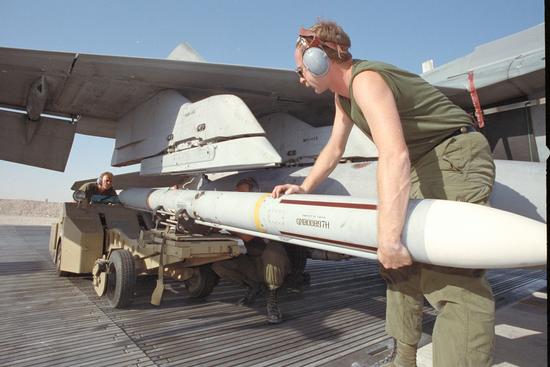
An air force weapons technician helps load a CF-18 warplane. December 16, 1990. Photo: Department of National Defence ISC90-5040
Canadian air operations during Desert Storm
Canada's biggest contributions during Operation Desert Storm came in the air. CF 18 jet squadrons and 500 personnel operated out of the “Canada Dry” bases in Qatar. As the conflict intensified, Canadian jets bombed Iraqi land and sea targets. It was the first time since the Korean War that Canadian air-to-surface attacks took place.
Canadian naval efforts during Desert Storm
The role of Canadian warships changed to a logistical role when the fighting began. They coordinated ship movements for the Coalition fleet. HMCS Terra Nova and HMCS Athabaskan also protected some Coalition ships that were farther away from the fighting. HMCS Athabaskan took part in a tense mission to aid the USS Princeton. Damaged by Iraqi mines off the coast of Kuwait, our sailors helped in the rescue of the American ship. HMCS Protecteur transported supplies and refueled other vessels as well.
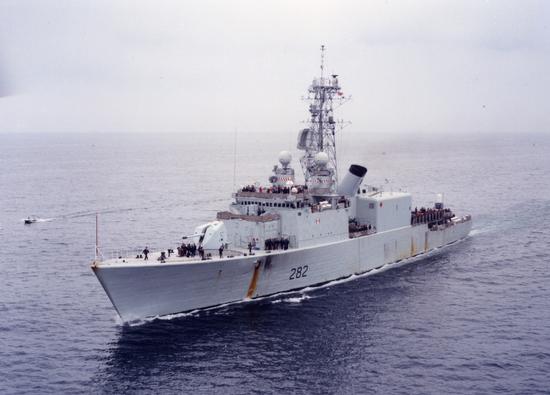
HMCS Athabaskan returns from escorting the cruiser USS Princeton in the northern Persian Gulf. February 1991. Photo: Department of National Defence
Ground combat
On 24 February 1991, Coalition forces began an intense ground combat campaign. It resulted in a lot of destruction, with most of the casualties coming from the Iraqi forces. Iraq put up a short fight as Coalition forces rapidly pushed them from Kuwait and back into Iraqi territory. As the Iraqis retreated, they set hundreds of Kuwaiti oil wells on fire.
First Canadian field hospital
Canada built a field hospital in Al Qaysumah, Saudi Arabia, near the Kuwait border in late February 1991. Its 530 personnel cared for both Coalition and Iraqi wounded. The fighting soon ended and the hospital stopped operating shortly thereafter.
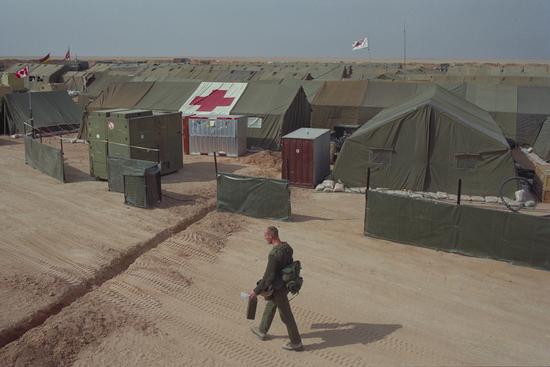
General view of the No. 1 Canadian Field Hospital in Al Qaisumah, Saudi Arabia. February 11, 1991. Photo: Department of National Defence REC92-1558
Coalition forces triumph
Coalition forces overwhelmed the Iraqi forces during Operation Desert Storm. One hundred hours after ground combat began, American President George H. W. Bush declared a ceasefire on 28 February 1991. The Coalition had liberated Kuwait.
The Coalition had defeated Iraq, but Saddam Hussein retained power. He controlled Iraq for more than 12 years until the second Gulf War swept him from power in 2003.
Post-war efforts
After the war was over, some CAF members remained in the Persian Gulf region. They carried out a variety of duties. For example, 23 Canadian military engineers took part in Operation Magnolia. In March 1991, these soldiers deployed to Kuwait. They spent three tense weeks destroying landmines and unexploded munitions in the country.
The UN also soon set up a peacekeeping mission. Peacekeepers monitored the border between Iraq and Kuwait and cleared landmines. Canada launched Operation Record to take part in this UN effort. Our peacekeepers served in military engineering, communications and military observer roles there.
CAF warships patrolled the region with Coalition vessels after the conflict. They helped enforce sanctions against Iraq. Canada assisted in diplomatic and rebuilding efforts. Our country also worked with a special international commission. This group searched for biological, chemical and nuclear weapons production facilities in Iraq.
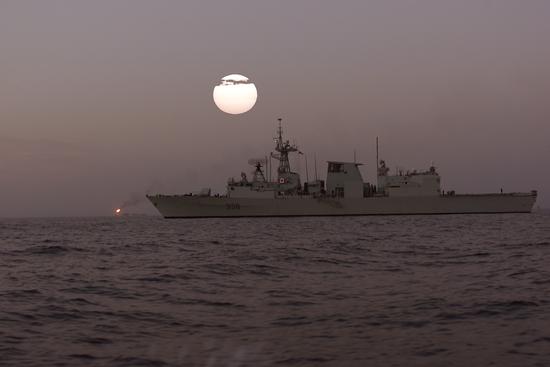
HMCS Winnipeg during a sunset in the Arabian Gulf while enforcing UN sanctions against Iraq in the aftermath of the Gulf War. May 19, 2001. Photo: Department of National Defence ISD01-4148
Sacrifice
Theatres of war, like the Persian Gulf in the early 1990s, are dangerous places. There are many risks that go beyond the obvious ones of enemy attack or landmines. No Canadians lost their lives during the Gulf War, but the stressful conditions took a toll on the physical and mental health of some of those who served there. Chronic fatigue, respiratory complaints and muscular pain have been a harsh reality for them.
Canadians have long been an important part of international military efforts around the globe. The Canadians who served in conflicts like the Gulf War have accomplished much. They have also made great sacrifices in the protection of peace and freedom worldwide.
- Date modified:
